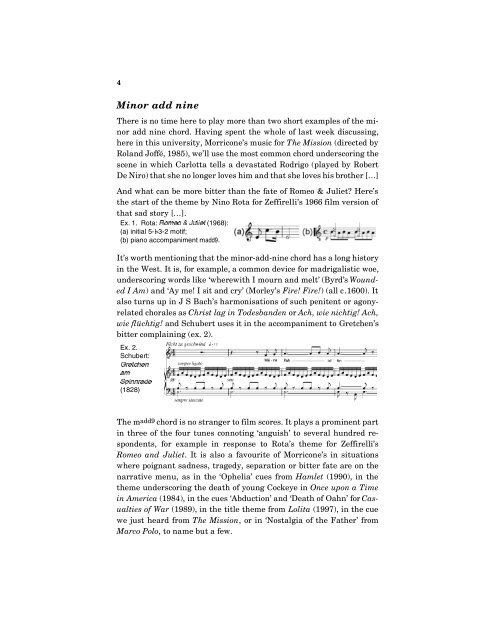You also want an ePaper? Increase the reach of your titles
YUMPU automatically turns print PDFs into web optimized ePapers that Google loves.
4<br />
Minor add nine<br />
There is no time here to play more than two short examples of the minor<br />
add nine chord. Having spent the whole of last week discussing,<br />
here in this university, Morricone’s music for The Mission (directed by<br />
Roland Joffé, 1985), we’ll use the most common chord underscoring the<br />
scene in which Carlotta tells a devastated Rodrigo (played by Robert<br />
De Niro) that she no longer loves him and that she loves his brother […]<br />
And what can be more bitter than the fate of Romeo & Juliet? Here’s<br />
the start of the theme by Nino Rota for Zeffirelli’s 1966 film version of<br />
that sad story […].<br />
Ex. 1. Romeo & Juliet Rota: (1968):<br />
(a) initial 5-$3-2 motif;<br />
(b) piano accompaniment madd9.<br />
It’s worth mentioning that the minor-add-nine chord has a long history<br />
in the West. It is, for example, a common device for madrigalistic woe,<br />
underscoring words like ‘wherewith I mourn and melt’ (Byrd’s Wounded<br />
I Am) and ‘Ay me! I sit and cry’ (Morley’s Fire! Fire!) (all c.1600). It<br />
also turns up in J S Bach’s harmonisations of such penitent or agonyrelated<br />
chorales as Christ lag in Todesbanden or Ach, wie nichtig! Ach,<br />
wie flüchtig! and Schubert uses it in the accompaniment to Gretchen’s<br />
bitter complaining (ex. 2).<br />
Ex. 2.<br />
Schubert:<br />
Gretchen<br />
am<br />
Spinnrade<br />
(1828)<br />
The madd9 chord is no stranger to film scores. It plays a prominent part<br />
in three of the four tunes connoting ‘anguish’ to several hundred respondents,<br />
for example in response to Rota’s theme for Zeffirelli’s<br />
Romeo and Juliet. It is also a favourite of Morricone’s in situations<br />
where poignant sadness, tragedy, separation or bitter fate are on the<br />
narrative menu, as in the ‘Ophelia’ cues from Hamlet (1990), in the<br />
theme underscoring the death of young Cockeye in Once upon a Time<br />
in America (1984), in the cues ‘Abduction’ and ‘Death of Oahn’ for Casualties<br />
of War (1989), in the title theme from Lolita (1997), in the cue<br />
we just heard from The Mission, or in ‘Nostalgia of the Father’ from<br />
Marco Polo, to name but a few.














